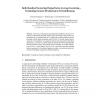1081 search results - page 55 / 217 » Spatial Models for Virtual Networks |
PIMRC
2010
IEEE
13 years 7 months ago
2010
IEEE
Abstract--In two-tier networks consisting of a macrocell overlaid with femtocells in co-channel deployment and closed-access policy, spatial reuse is achieved at the price of sever...
MOBISYS
2003
ACM
14 years 8 months ago
2003
ACM
Advances in sensing and tracking technology enable location-based applications but they also create significant privacy risks. Anonymity can provide a high degree of privacy, save...
AINA
2006
IEEE
13 years 11 months ago
2006
IEEE
This paper presents DiV ES, a distributed support for the development of networked Distributed Virtual Environments. DiV ES exploits the publish subscribe interaction model to def...
INFOCOM
2011
IEEE
13 years 27 days ago
2011
IEEE
—It is well-known that the application of directional antennas can help conserve bandwidth and energy consumption in wireless networks. Thus, to achieve efficiency in wireless n...
IVA
2010
Springer
13 years 7 months ago
2010
Springer
Abstract. How does a virtual agent’s gesturing behavior influence the user’s perception of communication quality and the agent’s personality? This question was investigated ...

